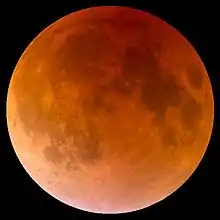September 2006 lunar eclipse
A partial lunar eclipse took place on September 7, 2006, the second of two lunar eclipses in 2006. The tables below contain detailed predictions and additional information on the Partial Lunar Eclipse of 7 September 2006.
| Partial eclipse | |||||||||||||
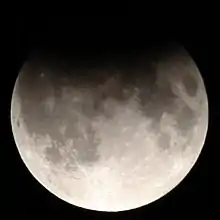 The eclipse as viewed from Bucharest, Romania | |||||||||||||
| Date | 7 September 2006 | ||||||||||||
|---|---|---|---|---|---|---|---|---|---|---|---|---|---|
| Gamma | -0.92619 | ||||||||||||
| Magnitude | 0.18375 | ||||||||||||
| Saros cycle | 118 (51 of 74) | ||||||||||||
| Partiality | 254 minutes, 28 seconds | ||||||||||||
| Penumbral | 91 minutes, 7 seconds | ||||||||||||
| |||||||||||||
Eclipse Characteristics
Date = 7 September 2006
Penumbral Magnitude = 1.13296
Umbral Magnitude = 0.18375
Gamma: -0.92619
Epsilon: 0 degrees, 56 minutes, 50.28 seconds
Saros Series = 118th (51 of 73)
Opposition Times
Greatest Eclipse = 07 Sep 2006 18:51:20.1 UTC (18:52:25.2 TD)
Ecliptic Opposition = 07 Sep 2006 18:42:03.3 UTC (18:43:08.4 TD)
Equatorial Opposition = 07 Sep 2006 18:00:00.9 UTC (18:01:06.0 TD)
Geocentric Coordinates of Sun and Moon
Sun right ascension = 11 hours, 4 minutes, 47.1 seconds
Moon right ascension = 23 hours, 6 minutes, 35.6 seconds
Earth's shadow right ascension = 23 hours, 4 minutes, 47.1 seconds
Sun declination = 5 degrees, 54 minutes, 23.1 seconds north of Celestial Equator
Moon declination = 6 degrees, 44 minutes, 25.6 seconds south of Celestial Equator
Earth's shadow declination = 5 degrees, 54 minutes, 23.1 seconds south of Celestial Equator
Sun diameter: 1904.8 arcseconds
Moon diameter: 2006.6 arcseconds
Geocentric Libration of Moon
Latitude: 0.5 degrees south
Longitude: 1.3 degrees east
Direction: 338.7 (NNW)
Earth's Shadows
Penumbral Diameter: 9360.72 arcseconds
Moon Diameter: 5551.2 arcseconds
Times
Penumbral Begins = 07 Sep 2006 16:44:06.4 UTC
Partial Begins = 07 Sep 2006 18:05:47.7 UTC
Greatest Eclipse = 07 Sep 2006 18:51:20.1 UTC
Partial Ends = 07 Sep 2006 19:36:54.4 UTC
Penumbral Ends = 07 Sep 2006 20:58:34.6 UTC
Total duration = 4 hours, 14 minutes, 28.2 seconds
Umbral duration = 1 hour, 31 minutes, 6.7 seconds
Eclipse Season
This is the first eclipse this season.
Second eclipse this season: 22 September 2006 Annular Solar Eclipse
Visibility
It was completely visible over most of Africa, Europe, Asia and Australia.

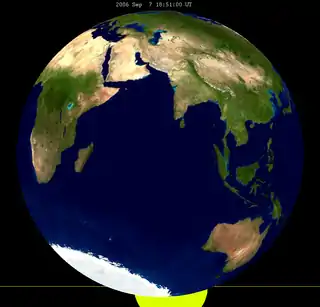
A simulated view of the earth from the center of the moon at maximum eclipse.
Map
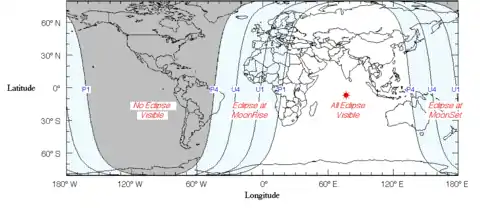
Relation to other lunar eclipses
Eclipses of 2006
- A penumbral lunar eclipse on March 14.
- A total solar eclipse on March 29.
- A partial lunar eclipse on September 7.
- An annular solar eclipse on September 22.
| Lunar eclipse series sets from 2006–2009 | ||||||||
|---|---|---|---|---|---|---|---|---|
| Descending node | Ascending node | |||||||
| Saros # and photo |
Date Viewing |
Type Chart |
Gamma | Saros # and photo |
Date Viewing |
Type Chart |
Gamma | |
113 |
2006 Mar 14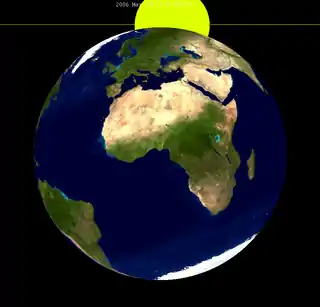 |
penumbral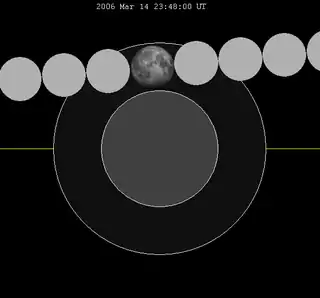 |
1.0211 | 118 |
2006 Sep 7 |
partial |
-0.9262 | |
123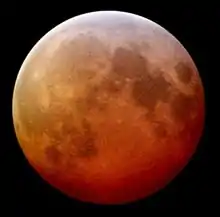 |
2007 Mar 03 |
total |
0.3175 | 128 |
2007 Aug 28 |
total |
-0.2146 | |
133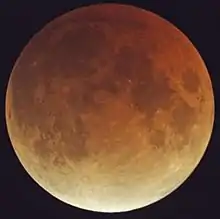 |
2008 Feb 21 |
total |
-0.3992 | 138 |
2008 Aug 16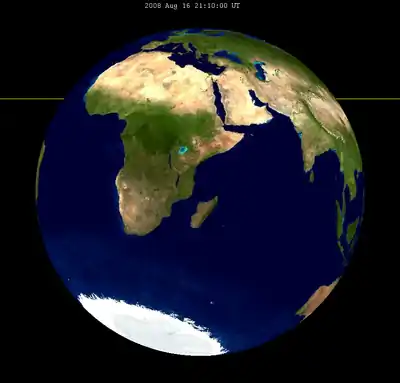 |
partial |
0.5646 | |
143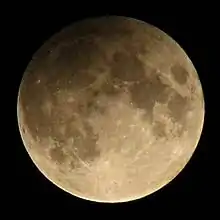 |
2009 Feb 09 |
penumbral |
-1.0640 | 148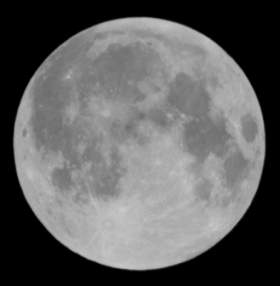 |
2009 Aug 06 |
penumbral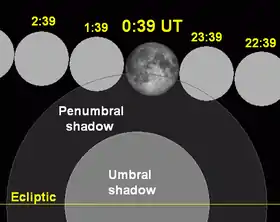 |
1.3572 | |
| Last set | 2005 Apr 24 | Last set | 2005 Oct 17 | |||||
| Next set | 2009 Dec 31 | Next set | 2009 Jul 07 | |||||
Metonic cycle (19 years)
This eclipse is the first of four Metonic cycle lunar eclipses on the same date, September 7, each separated by 19 years:
The Metonic cycle repeats nearly exactly every 19 years and represents a Saros cycle plus one lunar year. Because it occurs on the same calendar date, the earth's shadow will in nearly the same location relative to the background stars.
|
|
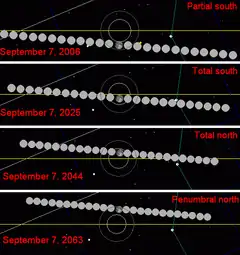 |
Half-Saros cycle
A lunar eclipse will be preceded and followed by solar eclipses by 9 years and 5.5 days (a half saros).[1] This lunar eclipse is related to two partial solar eclipses of Solar Saros 125.
| September 2, 1997 | September 13, 2015 |
|---|---|
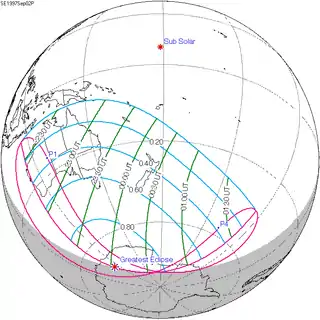 |
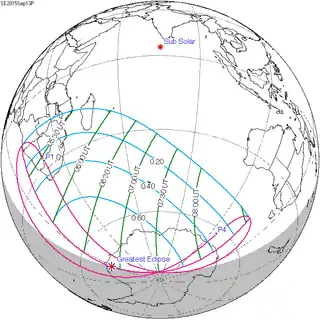 |
See also
- List of lunar eclipses and List of 21st-century lunar eclipses
- May 2003 lunar eclipse
- November 2003 lunar eclipse
- May 2004 lunar eclipse
- File:2006-09-07 Lunar Eclipse Sketch.gif Chart
References
- Mathematical Astronomy Morsels, Jean Meeus, p.110, Chapter 18, The half-saros
External links
- 2006 Sep 07 chart: Eclipse Predictions by Fred Espenak, NASA/GSFC
- Hermit eclipse: 2006-09-07
- Photo
- photo from New Zealand
| Wikimedia Commons has media related to Lunar eclipse of 2006 September 7. |
.jpg.webp)
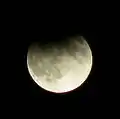
.jpg.webp)


